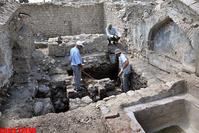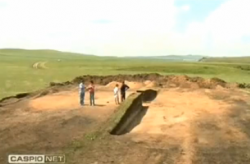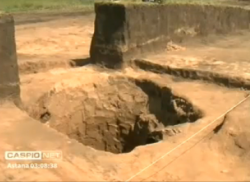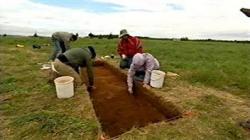- 11 JUILLET
- INDI-UNI : 
PRE-INSCRIPTION : 15 Juin – 15 Août
PRE-REGISTRATION: June 15th - August 15th
- AZERBAIDJAN –  Gabala - The archaeological excavations began in the Azerbaijani town of Gabala, the head of the Gabala expedition of the Archaeology and Ethnography Institute of the Azerbaijani National Academy of Sciences, doctor of historical sciences Gafar Jabiyev told Trend. He said that the excavations in the territory of the Gabala fortress are made by the Institute of Archaeology and Ethnography of the Azerbaijani National Academy of Sciences with financial support of the Azerbaijani-Korean Association for Cultural Exchange. "A fortress is a place where people live for a long time in Gabala," he said. "People lived from I century BC to the XVIII century AD in this area. The city is a place where people lived for 2,000 years." He expressed confidence that the excavations will help to clarify many obscure aspects of the history of the city. He said that archaeologists, historians, ethnographers and architects take part in the excavations.
Gabala - The archaeological excavations began in the Azerbaijani town of Gabala, the head of the Gabala expedition of the Archaeology and Ethnography Institute of the Azerbaijani National Academy of Sciences, doctor of historical sciences Gafar Jabiyev told Trend. He said that the excavations in the territory of the Gabala fortress are made by the Institute of Archaeology and Ethnography of the Azerbaijani National Academy of Sciences with financial support of the Azerbaijani-Korean Association for Cultural Exchange. "A fortress is a place where people live for a long time in Gabala," he said. "People lived from I century BC to the XVIII century AD in this area. The city is a place where people lived for 2,000 years." He expressed confidence that the excavations will help to clarify many obscure aspects of the history of the city. He said that archaeologists, historians, ethnographers and architects take part in the excavations.
http://en.trend.az/news/society/1903186.html
- CHINE –Qinghai - In the silent mountains of the Qinghai-Tibet Plateau, an old Tibetan man herds his sheep near the 1,500-year-old tombs to protect them from grave robbers.H "The robbers used to be quite rampant here, and who knows how much treasure they stole, but it really hurts when I think about it," said Shihorgya, the 55-year-old grave keeper of the 2,000 tombs in Reshui Village in Dulan County in Haixi Mongol and Tibetan Autonomous Prefecture. In the 1980s, the ancient tombs were identified as being built during the Tuyuhun Kingdom (417A.D.-688A.D.). They were listed as one of the top six national archeology discoveries of the year in 1983, and listed as one of the national key units of cultural relics protection in 1996. As the connection between ancient central China and ancient Tibet, the Tuyuhung Kingdom was on the South Silk Road, which was unimpeded after the 7th century as the empire had been protecting the trade passage with their castles and daks, while the Silk Road in northern China was blocked by wars and riots, said Xu Xingguo, an archeologist at the Archaeology Institute of Qinghai Province, who is in charge of the excavation of the graves. "The empire played an important role to protect the communication and trade between the two places, and the countless cultural relics are of great value," Xu said. In front of Shihorgya's home, a nine-floored tomb was identified to be the most magnificent large imperial tomb belonging to Empire of Tuyuhun, which was built in the eagle-shaped mountains. It had been robbed before the archaeologists arrived. The archaeological work was launched in 1983, but thieves remained rampant at the end of 2000, said Han Musheng, director of cultural bureau of Dulan County. Just in the year 2000, robbers raided 130 graves, he added. The tombs are praised to be "Tibetan-Han Civilization Pyramid," as hundreds of thousands of cultural relics from ancient central China and the Tibet have been unearthed here, Xu said. "The graves are solid history that show the amalgamation of Tibetan people and Han people," Xu said. Thousands of pieces of silk were discovered here, which still have clear patterns and bright colors. The architect style of the tombs as well as the silk patterns are all in Tang Dynasty style, which means they were widely used in Yuyuhun and Tibetan areas, Xu said. Special patterns that include birds and other animals were adopted in the silk patterns, and Chinese characters can be seen on the unearthed relics, he said. As robbers continued to threaten site, the county's government has launched a series of measures to stop them, Han said.
http://news.xinhuanet.com/english2010/china/2011-07/11/c_13978524.htm
- KAZAKHSTAN – 
 Akmola - Archaeologists from the Gumilyov Eurasian National University have found a mound, presumably dating back to the Iron age. The tomb of Sarmatian warrior is located near the village of Aidarly in the Akmola region. In the mound, archeologists also found arrowheads, knives, an iron belt badge, ceramic vessels and the bones of sacrificial animals. Sergazy Saken, Archeological Expedition Leader: ‘The body of the middle-class warrior is place with its head towards the south which is peculiar for Sarmatians and dates back to 3rd or 4th centuries BC. The artifacts found in the tomb were placed near the body with two vessels near the head and one vessel near the feet. Here, you can see the peculiarities of the grave artifacts. On the left, you can see earrings but in that time, they were wearing earrings in ears.’ The expedition carried out excavations in the village of Kenetkol. Under a layer of earth, archeologists found a dwelling, dating back to the Bronze age. Inside, they were found fragments of clay pots of the 14th or the 13th centuries BC. Experts believe the findings belong to the Alakol culture. Archaeological expeditions have been working in the Akmola region for two years now and a monograph is to be published as a result of its work.
Akmola - Archaeologists from the Gumilyov Eurasian National University have found a mound, presumably dating back to the Iron age. The tomb of Sarmatian warrior is located near the village of Aidarly in the Akmola region. In the mound, archeologists also found arrowheads, knives, an iron belt badge, ceramic vessels and the bones of sacrificial animals. Sergazy Saken, Archeological Expedition Leader: ‘The body of the middle-class warrior is place with its head towards the south which is peculiar for Sarmatians and dates back to 3rd or 4th centuries BC. The artifacts found in the tomb were placed near the body with two vessels near the head and one vessel near the feet. Here, you can see the peculiarities of the grave artifacts. On the left, you can see earrings but in that time, they were wearing earrings in ears.’ The expedition carried out excavations in the village of Kenetkol. Under a layer of earth, archeologists found a dwelling, dating back to the Bronze age. Inside, they were found fragments of clay pots of the 14th or the 13th centuries BC. Experts believe the findings belong to the Alakol culture. Archaeological expeditions have been working in the Akmola region for two years now and a monograph is to be published as a result of its work.
http://caspionet.kz/eng/general/New_archeological_find_discovered_in_Akmola_region_1310102988.html
- PORTUGAL –  Alcaçer do Sal - Archaeologists have discovered an unprecedented 8,000-year-old dog tomb – the oldest in southern Europe – in a shell mound near the Portuguese town of Alcaçer do Sal. Project co-director Mariana Diniz told Lusa News Agency the find held “significant importance” because previously there had been no such sign of ancient “canine symbology” in southern Europe, in contrast to northern parts of the continent. “Eight thousand years ago [southern] communities domesticated dogs, an animal with an economic role, but also a symbolic one”, Ms. Diniz said. “The ritual burial of dogs was done with care, not just any way, with special significance”, she added of the find. Lisbon’s National Museum of Archaeology has dispatched a specialist team to the site to consolidate and remove the tomb for conservation and future public display. The find was made by archaeologists from Lisbon University and the Spanish University of Cantabria.
Alcaçer do Sal - Archaeologists have discovered an unprecedented 8,000-year-old dog tomb – the oldest in southern Europe – in a shell mound near the Portuguese town of Alcaçer do Sal. Project co-director Mariana Diniz told Lusa News Agency the find held “significant importance” because previously there had been no such sign of ancient “canine symbology” in southern Europe, in contrast to northern parts of the continent. “Eight thousand years ago [southern] communities domesticated dogs, an animal with an economic role, but also a symbolic one”, Ms. Diniz said. “The ritual burial of dogs was done with care, not just any way, with special significance”, she added of the find. Lisbon’s National Museum of Archaeology has dispatched a specialist team to the site to consolidate and remove the tomb for conservation and future public display. The find was made by archaeologists from Lisbon University and the Spanish University of Cantabria.
http://www.theportugalnews.com/cgi-bin/article.pl?id=1120-22
- CANADA –  Pointe aux Vieux - Les archéologues fouillent l'endroit où se dressait autrefois le village acadien de Pointe-aux-Vieux, à l'Île-du-Prince-Édouard, avant qu'il disparaisse sous l'effet de l'érosion. La province protège le site contre toute forme d'exploitation, mais l'érosion demeure une menace importante. L'archéologue Meghan Ferris s'attriste de voir la progression de la mer à cet endroit. Elle explique qu'une tempête, l'hiver dernier, a érodé plus d'un mètre de terrain. La mer a mis au jour un four, qui est l'une des plus imposantes découvertes à Pointe-aux-Vieux. Ce four était bien enraciné dans la terre ferme l'an dernier. Les archéologues essaient de recueillir le plus d'information possible cet été, ne sachant pas dans quel état ils trouveront les lieux l'an prochain.
Pointe aux Vieux - Les archéologues fouillent l'endroit où se dressait autrefois le village acadien de Pointe-aux-Vieux, à l'Île-du-Prince-Édouard, avant qu'il disparaisse sous l'effet de l'érosion. La province protège le site contre toute forme d'exploitation, mais l'érosion demeure une menace importante. L'archéologue Meghan Ferris s'attriste de voir la progression de la mer à cet endroit. Elle explique qu'une tempête, l'hiver dernier, a érodé plus d'un mètre de terrain. La mer a mis au jour un four, qui est l'une des plus imposantes découvertes à Pointe-aux-Vieux. Ce four était bien enraciné dans la terre ferme l'an dernier. Les archéologues essaient de recueillir le plus d'information possible cet été, ne sachant pas dans quel état ils trouveront les lieux l'an prochain.
http://fr-ca.actualites.yahoo.com/arch%C3%A9ologie-%C3%A0-la-d%C3%A9couverte-des-secrets-pointe-aux-144608786.html
- ROYAUME UNI – Newmarket - A television show has unearthed remains of King Charles II's original stables during excavations at Newmarket’s Palace House – but the roots of the site may extend further into the past.A 15-strong team of archaeologists from Channel 4’s Time Team descended on Newmarket on Monday and uncovered remains of the stables, which were built in the 1670s. The find came in the first trench dug in King’s Yard on the Palace House site. Mr Robinson said the possibility the site was in use before Charles’s time was suggested by a wall absent from the team’s 17th century plans. Chris Garibaldi, director of the National Horseracing Museum, said King James I may have built his own stables there in the 1620s. He said the dig had revealed the fashionable red brick used as part of the palace itself was also used for the luxurious stables’ façade.
http://www.cambridge-news.co.uk/Home/Time-Team-unearths-stables-fit-for-a-king-08072011.htm
- INDE – Ajanta - The Ajanta Caves, a world heritage site located 5km northeast of Aurangabad, are under threat because of high carbon dioxide (CO2) content resulting from increasing human interference, the Archaeological Survey of India (ASI) has said. The ASI has conducted a five-year climate monitoring study inside the caves. The source of CO2 in the caves is exhalation by visitors. Ajanta Caves attract 6,000-7,000 tourists a day during the peak season of October to January and about 4,000 visitors a day during the rest of the year. The CO2 content increases by 20-30% when the caves are opened for visitors. “It is worth mentioning that with the higher relative humidity inside the caves, there is a chance of reaction between the calcium carbonate of the white pigments and CO2, changing into biocarbonates with time, thus causing loosening of the grains,” said M Singh, head of ASI regional office in Aurangabad. The high content of CO2 has already had an impact on the ceiling paintings inside cave No 2, where white pigments from the ceiling have come off. “For the survival of the paintings, it is essential to introduce proper visitor management at the caves,” Singh said in a research paper to be published next week.
http://www.hindustantimes.com/Carbon-dioxide-content-threatening-Ajanta-Caves-ASI/Article1-719059.aspx